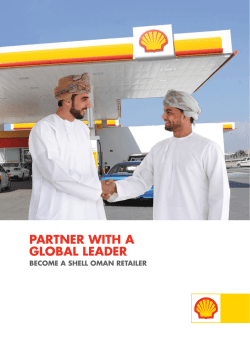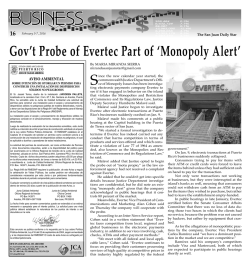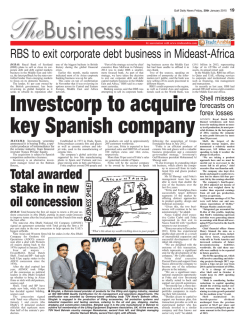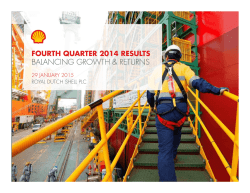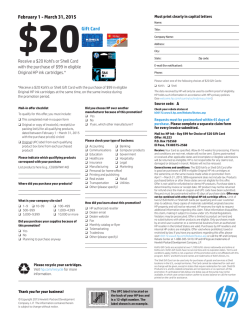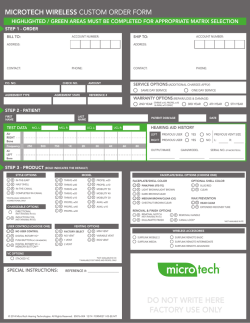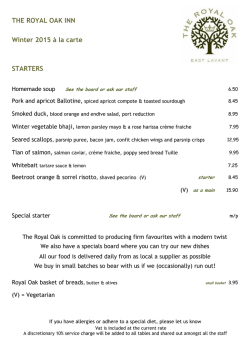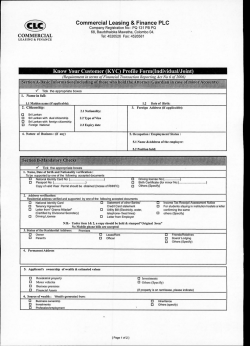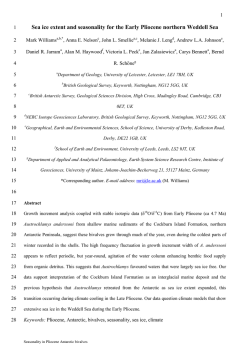
Q4 2014 transcript of presentation to media
ROYAL DUTCH SHELL PLC FOURTH QUARTER AND FULL YEAR 2014 RESULTS JANUARY 29TH 2015 FOURTH QUARTER AND FULL YEAR 2014 RESULTS WEBCAST TO MEDIA BY BEN VAN BEURDEN, CHIEF EXECUTIVE OFFICER OF ROYAL DUTCH SHELL PLC AND SIMON HENRY, CHIEF FINANCIAL OFFICER OF ROYAL DUTCH SHELL PLC Ladies and gentlemen, a very warm welcome to you all. First, the disclaimer statement. I’m looking forward to updating you on what we’ve achieved in 2014, and our plans for the future. Simon Henry, our CFO, is here with me, and he will talk to you about the results and some of our plans. First and foremost, the health and safety of our people and our neighbours, and our environmental performance remain the top priorities for Shell. I believe we have the right safety culture in the company. Our track record is improving and competitive, but we did regrettably have fatalities and other safety incidents in 2014, and we will continue with our safety drive, which is called Goal Zero, to further improve here. We are following a consistent and long-term strategy to grow our cash flow across the cycle and deliver competitive returns. Shell is an industry leader in deep water and integrated gas; in technology and integration; and large-scale project management. We have some of the most talented people in our industry working at Shell and they are working on adding more value for shareholders. Our dividend track record is, I think, second to none - $15.2 billion of dividends and buybacks in 2014 - underlining our commitment to shareholders. Let me make some comments on the macro, and I will start with the longer-term picture. We expect the world’s population to grow from 7 billion today to 9 billion by 2050, and this is driving strong demand for energy - a 50% increase since 1990, and another 50% by 2050. This is an investment opportunity for companies like Shell, to create value for shareholders. However, to meet this demand growth, governments and society need to deal with a number of realities: fossil fuels were 80% of the energy mix 20 years ago, they are 80% of the energy mix today, and are expected – by IEA and others – to be around that level in 20 years’ time. Oil and gas are going to be important parts of the energy mix for decades to come. The thesis that there won’t be a market for hydrocarbons in a few decades time misses the point that more energy is required, as well as less CO2. Without sustained and substantial growth investment, there will be considerable shortfalls in oil & gas production in the next decades - not a surplus of supply - due to demand growth and natural field decline. There are important energy transitions underway in response to requirements from society to mitigate climate change. Reducing coal emissions in the energy mix has to be an imperative. Coal has double the CO2 emissions of gas in the power generation sector. We think that using more gas in the power sector, and deploying more carbon capture and storage both have a ROYAL DUTCH SHELL PLC FOURTH QUARTER AND FULL YEAR 2014 RESULTS key role to play here. Overall, to address the dual challenges of more energy and less CO2, we need to see a more balanced debate here, based on realism and economics, not soundbites, to provide solution-oriented policies for the right investment climate. OK. Those are some comments on the longer-term energy supply position. Turning to the nearer term, and the weak oil price environment at the start of 2015. A year ago, when I updated you on fourth quarter 2013, oil prices were around $108. They are quite a bit lower than that today. Volatility is a fact of life in our industry. It is what it is, and we have to manage through it - and there are some important lessons from history. Short-term movements in oil prices can be driven by perception, and prices tend to over-react on both the upside and the downside. In the medium term, supply and demand fundamentals tend to reassert themselves around the marginal cost of supply. We have not changed our long-term planning assumptions of $70-$90-$110 Brent. The long-term demand outlook remains robust, and industry under-investment today simply leads to more upside risk in oil prices in the future. However, we have to think carefully about the implications of today’s prices, which are below our planning range, and we don’t have much visibility on how long this downturn will last months or years. We set out on a programme in early 2014 to moderate our capital spending and growth outlook, due to both inflationary and affordability pressures, and in hindsight the timing of that change was pretty good. Today, we are taking steps to preserve Shell’s financial flexibility: this includes a freeze in dividends and a slow-down in capital spending in 2015, taking choices on Shell’s rich portfolio funnel, and opportunities to take out cost, where there are multi-billion dollar opportunities in our own cost base, and in the supply chain. At the same time, we have to be careful not to over-react to spot prices. We are maintaining the downward pressure on our capital spending, and we have plans in place today to further reduce our spending if need be. But at the same time, we are continuing with a very attractive suite of new projects which are under construction, and are preserving, where we can, a competitive set of new options for medium-term shareholder value creation. Shell’s financial performance has improved in 2014, from a more challenging baseline in 2013 and, underlying earnings and returns, and CFFO, have all increased last year. This is reflected in the 4% increase in dividend last year, and $3.3 billion of share buybacks. The company is relatively well-positioned into the lower oil price environment in early 2015, with the 2014-15 asset sales programme already completed, $25 billion of free cash flow in 2014, and gearing at 12% at year-end. The plans that we set out a year ago are yielding results as we balance growth and returns. We’ve delivered a more robust financial performance and we have made progress with restructuring in Oil Products and North America resources plays. Our capital efficiency drive is starting to show up in the results and our projects came on-line as planned -new deep-water start-ups, especially in the Gulf of Mexico - with around 150,000 boe per day of potential for Shell. Last year saw the successful integration of the Repsol LNG acquisition which delivered more than $1 billion of CFFO in 2014, ahead of the potential we had assumed when we bought the position. ROYAL DUTCH SHELL PLC FOURTH QUARTER AND FULL YEAR 2014 RESULTS We’ve also come a long way with bedding down the changes I wanted to see in the way that we manage the portfolio and the appraisal, on behalf of the shareholders. A series of performance units, around 140 of these, drive bottom line thinking in value chains and major assets. I, and my Executive Committee colleagues, will personally appraise some of these performance units in 2015, and for the most part this appraisal will be run now by the top 200 managers in the company. We’ve implemented stronger, more centralised decision-making on the major portfolio choices at an earlier stage, before FEED decisions for the larger projects, and the top 200 managers will have to own at least 1.5 times base pay in Shell shares - 7 times base pay in shares for the CEO. We’ve achieved a lot in 2014, but the macro-environment today has moved against us, maybe that’s actually an advantage, and there’s no complacency here with plenty to do and I’m convinced we can deliver better profitability from the company for our shareholders, whatever the oil price happens to be. The approach we set out in 2014 is working, and I want to continue with this emphasis in 2015 and beyond. We’ll continue with a drive to improve the competitive financial performance including restructuring in under-performing businesses and reducing our operating costs in 2015. Capital efficiency is key in our industry. We want to continue to invest for medium-term growth, but to manage our affordability and improve our returns, we expect to reduce our spending for 2015 to below 2014 levels. This is forcing us to take some healthy choices on the project set, and we are setting higher expectations for value from the supply chain. Shell is retaining flexibility for both opportunistic, incremental plays but we will further reduce spending should market conditions warrant that step. On the growth side, we will see the benefits of the 2014 start-ups in this year’s results but overall 2015 will be a transition year ahead of the contribution from the next wave of large projects, from 2016 and onwards. We said a year ago that the financial performance in both North Americas resources plays and in Oil Products was frankly not acceptable and we’ve been working hard to turn this around with some $8 billion of asset sales, capital ceilings, and $7.5 billion of write-downs in 2013-14 in these two areas. We will be continuing in 2015 and beyond with a strong performance drive in Oil Products and world-wide resources plays - not just in North America and we want to improve in our Upstream engine plays where free cash flow has fallen substantially in recent years. Let me give you more details on these three restructuring themes. Firstly on resources plays. We’ve made a lot of progress with North America restructuring in 2014 and we are extending that drive into resources plays world-wide here. In recent years, the company has taken up acreage and options in a number of countries. However, in many cases, we have seen mixed well results, and above ground issues. This, combined with capital ceilings in the company, means that we won’t go forward with all of this portfolio. Resources plays spending outside of North America will be cut by around $200 million, 20%,.in 2015, and we expect to exit from several positions. This may potentially result in new impairments and well write downs, which are not always taken as identified items, and we will update you on that as the year progresses. ROYAL DUTCH SHELL PLC FOURTH QUARTER AND FULL YEAR 2014 RESULTS In North America in dry gas we have a strong position in Western Canada, which will be targeted at LNG and we also have gas acreage in Appalachia, where we are appraising some interesting new discoveries in the Utica. In liquids rich plays, we have retained Western Canada and Permian acreage for further appraisal and development. North America resources plays remained in loss in 2014, $1.2 billion on a clean basis, although this does represent a positive swing of $1.7 billion compared to 2013. We are progressing to a more competitive cost structure here, taking out some $550 million of operating and capital costs on a like-for-like basis. This will be a multi-year pathway to profitability. It’s a difficult area, but one we are determined to stay in, get right, and make it into a strong business for shareholders. Overall, resources plays are an area where we are continuing to dial down our spending as we moderate our growth outlook and implement capital ceilings across the company. Turning to Downstream. We’ve been busy here with portfolio restructuring and self-help programmes. The changes we have made in Downstream in the last 18 months have unlocked substantial new revenue opportunities, and taken out costs. It is good to see Downstream return on capital employed increasing to 11%, and CFFO was $11.3 billion for 2014, which is an improvement on 2013 levels, in a lot of ways effectively delivering the step up that we were targeting. The main drivers of that, aside from industry margins, were uplift from self-help, including cost take-out, and exits from low margin portfolio. We are redoubling our efforts on Downstream costs, with a new, multi-year cost programme launched at the end of 2014. This will include staff reduction, increasing the use of low cost shared service centres for back office activities, and a continued drive to improve global contract management for capital and operating spending. Overall, this is an improved position, but there is more to come here, in a multi-year turnaround strategy for Downstream, which needs to be a $10 billion per year CFFO, 10-12% return on capital employed business on a sustained basis, not just for a few quarters. We are continuing to take a hard look at the building blocks that make up the Downstream portfolio. There are some strong businesses with growth potential here, such as lubes and China, but on the flip-side, there are parts of our portfolio where others can simply add more value, or where we would rather spend the capex elsewhere in the company. Divestment of the Australia, Italy and other positions last year, and the successful launch of the US midstream MLP led to over $4 billion of proceeds in 2014. It was good to see a return to profit in the Motiva joint venture in 2014, despite margin pressure in the fourth quarter. But in other areas, there’s more to do still, for example in Singapore fuels, where the recent start-up of debottlenecking at the Bukom ethylene cracker and new co-generation in 2015, will both improve integration value there. Malaysia and Europe remain challenging areas in Oil Products, however. We need to fix these assets and that is what we are doing now. I want to be clear that this is a multi-year story - no quick fixes. Turning then to Upstream engines, where as I said, the free cash flow position has declined sharply recently. This is now a major focus for the company. These are Shell’s mature basins, such as offshore Europe and South East Asia, where we are in many cases producing oil & gas from fields that have run for many years longer than their original design lives because of the uplift from technology and higher oil prices. There are some good success stories here, for ROYAL DUTCH SHELL PLC FOURTH QUARTER AND FULL YEAR 2014 RESULTS example Oman, where production has been steady at around 200,000 boe per day for Shell in recent years, offsetting the effect of natural field decline. Looking further into the future, we have a series of projects under construction in the Europe Upstream which is currently reducing our free cash flow in the investment phase and some of this will reverse as capex rolls off into cash generation, particularly from 2017 and onwards. Fundamentally, though, I want to be clear that our engines businesses in Upstream around the world, with a few exceptions, are under pressure from aging assets and depleting fields and there are some tough decisions ahead of us. We are allocating capital on a global, thematic basis, and you can see the main categories here and the financial performance. The “engines” businesses, in Downstream and Upstream, are mature, and they are there to provide free cash flow - $7.5 billion in 2014. The “growth priorities”, deep water and Integrated Gas, are where Shell has leadership positions in the industry and the “longer term” category covers potentially very large positions for Shell in the future such as resources plays, heavy oil and Iraq. It was good to see positive momentum in earnings and returns in most of these themes in 2014, despite an average $10 drop in Brent prices since 2013. The company has a rich near-term opportunity pipeline and we are in a position where we have to manage our spending downwards firmly, to balance returns with growth, and moderate our growth outlook overall. We’ve curtailed our potential spending coming into 2015, postponing FIDs that were planned in the existing base portfolio and for our new growth projects, as well as setting expectations for cost reduction in the supply chain. 2015 organic capital spending is expected to be lower than 2014 levels, and the final outcome will be driven by the pace at which we take decisions on our portfolio, and the response from the supply chain. We are continuing to challenge ourselves and everyone in Shell to ensure that our plans are credible, that they are competitive, and that they are affordable. We must get the balance right between retaining Shell’s growth pipeline, and at the same time having the levers to pull if we need to further reduce our capital spending. Asset sales including US midstream MLP - $15 billion delivered in 2014 - add focus here, both from an affordability perspective, and driving better performance from the company. Now, let me hand you over to Simon to give you more details on the financial framework and today’s results announcements. Thanks Ben. Good to be here to talk to you today. I‘m going to update you on Shell’s financial framework. But first, let me briefly summarise 2014. Excluding identified items Shell’s underlying CCS earnings were $22.6 billion for 2014, a 15% increase in earnings per share from 2013. We saw higher earnings in Upstream, despite a $10 drop in Brent prices and higher results in Downstream, supported by industry margins and Shell’s self-help programmes. ROYAL DUTCH SHELL PLC FOURTH QUARTER AND FULL YEAR 2014 RESULTS In Upstream, we are seeing uplift from new, high margin production from growth in areas such as the Gulf of Mexico, from LNG, and less downtime in the production. And in Downstream we started to see the benefits of Shell’s actions in the last year or so to address underperforming portfolio and sell down non-core positions. Fourth quarter results were $3.3 billion excluding identified items, an increase of 13% on an earnings per share basis. These results were impacted by sharply lower oil prices, with some help from much-improved Oil Products results and strong underlying upstream volumes. Return on average capital employed for 2014 was 10.2%, excluding identified items, and cash flow from operations was $45 billion, an increase of 11% on 2013’s performance. Our dividend for 2014 was up 4% from year-ago levels and distributions were $15.2 billion in 2014; including dividend declared and share buy backs. You will find all the details of our SEC reserves in the Annual Report and 20F which will be filed in March. We are expecting that our 2014 headline proved reserves replacement ratio will be 26%, and the 3-year average around 67%. Our preliminary 3-year average RRR on an organic basis would therefore be 85%, or 47% in 2014, setting aside acquisitions, divestments and oil & gas price impacts. The reserves base is around 13.1 billion barrels oil equivalent or 11.2 years of reserves life at current production levels. We look at resources, as well as reserves as we manage the Upstream portfolio. This chart shows a sub-set of the total position. Resources on stream remain relatively stable, despite the asset sales in 2014. With fewer large investment decisions last year, as we reduced our capital spending, and with decisions to sell some positions and defer future FIDs, there is a consequent reduction in barrels in the underconstruction and design categories. And you can see a series of large projects in the decision queue - Appomattox could be 150,000 boe per day, Vito 100,000 boe per day, and other examples. Now, let me update you on conventional exploration, where I’m pleased to see that our performance has improved in 2014. We are driving strong top-down decision-making in exploration, with capital allocation in a series of precise risk and size-banded categories. Drilling adds short-term value through near-field activity, with medium and longer term potential through expanding our heartlands, frontier exploration and Arctic positions. We held the 2014 budget flat at $4 billion, and absorbed increased exploration spend on Libra, in Brazil, within that figure, following the acquisition in 2013. For this year, we’re planning on drilling in Alaska in 2015, subject to getting the permits and legal clearance, with higher spending there. But at the same time we are keeping overall spending on conventional exploration flat again at 2014 levels, at around $4 billion, as part of the capital ceiling in the company. This means spending outside of Alaska will be less than $3 billion in 2015 - a reduction from 2014 levels - and this has required some deferrals, for example in the Gulf of Mexico, China offshore and Malaysia. Drilling last year - you can see the details on the slide - resulted in 10 new frontier and heartland discoveries, Malaysia, the Gulf of Mexico, and Gabon, for example. In the Gulf of Mexico, the Rydberg discovery at just over 100 million barrels takes Appomattox area resources potential to over 700 million barrels and the Kaikias oil find in the Mars basin should become a high-value tie back into one of the platforms we have there. We’ve also made two further discoveries in the Gulf of Mexico in fourth quarter of 2014: Gettysburg, which is in the Appomattox area, and Power Nap, which is near Vito. We are assessing the potential of these ROYAL DUTCH SHELL PLC FOURTH QUARTER AND FULL YEAR 2014 RESULTS finds, taking the total number of discoveries in the Gulf of Mexico to 4 in 2014 and over 1.3 billion barrels of resources added for Shell there since 2009. We’ve also made 41 near field finds in Oman, The Netherlands, Brunei, Germany, Egypt and Australia, which should be highvalue add-ons in our Upstream engine businesses. All of this marks a substantial step-up in our exploration performance and 2014 was the most successful year we have had with the drill bit for several years, and highly competitive in the industry. This is a better performance from exploration and we are laying the foundations for the future. Now, turning to the financial framework. Our financial framework is straightforward and it has not changed here, and we are clearly going to be testing the downside in oil prices in 2015. We use our cash after servicing debt to fund a competitive dividend and after that to invest for future growth. Dividends are the main route for cash returns to our investors. This is a high priority for the company, and I think our track record is second to none. Today, oil prices are relatively low and we slowed down on share buybacks at the end of 2014 to conserve cash. We take on debt in down-cycles or when the company is in a capital-intensive stage. There is no formula for the right level of debt, but we want to keep gearing below 30% and above zero, with short-term moves outside of that range being acceptable so long as there is a clear pathway to return into the range. There are cost reduction programmes in place across Shell, looking not only at our own costs, but also in the supply chain. These programmes are balanced against the different strategic activities in the company, we’re not chasing costs for costs’ sake, and we are careful to make sure none of this compromises safety. We are planning to put Shell’s operating costs on a downwards trajectory here, with opex in 2015 expected to be lower than 2014 levels. You can see an example of cost take-out on the slide here, in North America resources plays, where we have reduced opex and capex by some $550 million in 2014 excluding portfolio effects. The Projects and Technology division is well-placed to work on supply chain costs where the annual contracting and procurement budget is over $60 billion. And overall, we think there is a multibillion cost opportunity for Shell here, in the downturn. Divestments are another route to improve the operating efficiency of the company and to recycle management time and dollars into the most attractive investments. The asset sales programme we set out a year ago has been completed and it feels good to have delivered those divestments before the downturn at the end of 2014. We expect to see some $5-6 billion per year of divestments as part of on-going portfolio management although the asset sales pace will slow here, after a substantial divestment programme in 2014. The divestment market today is more difficult than a year ago - there’s just less financing capacity out there. Despite that, we are marketing some positions today, such as non-core downstream, some deals underway in Nigeria SPDC, and potentially dilution of some of our growth positions. There’s no fire sale here, and let’s see how this progresses. Oil and gas production averaged 3.1 million boe per day in 2014, down from 3.2 million boe per day in 2013. The positions we’ve sold last year do reduce headline production by about 6%, including licence expiries, and there will be further impacts in 2015 of over 100,000 boe per day compared to 2014. But at the same time, we’ve brought high-margin production onstream, for example in deep water, and consolidated plays such as the Repsol LNG acquisition, ROYAL DUTCH SHELL PLC FOURTH QUARTER AND FULL YEAR 2014 RESULTS which came of course without Upstream production so that the underlying volume growth picture was an increase of 2%. Financial results are more important than the barrels. Excluding oil and gas price effects and working capital, Upstream cash flow from operations increased by some 25% year-on-year averaging some $30 per boe, compared to $26 per boe in 2013, on a like-for-like oil price. We have exited positions with low unit cash flow, and in some cases high levels of on-going capital spending; seen the benefits of Iraq cost recovery; and increased our high-margin production. All of this has led to enhanced profitability in 2014, and we will continue to prioritise profitability ahead of top-line volumes. We are allocating capital in the company through several lenses. From a portfolio and strategy perspective, on the left-hand side of this diagram, we want to continue to prioritise growth in LNG and deep water, which are themes where Shell has strong competitive advantages and compelling growth opportunities. This accounts for about 40% of our total capital investment. At the same time, we’ll continue to invest in maintenance programmes and selective growth opportunities in the Upstream and Downstream engines, and investment in longer-term plays, such as shales, Iraq and heavy oil. On the right-hand side of this chart you can see the time-frames for the different types of capital allocation. About 40% of the 2015 budget is on care and maintain activities and small projects in the base, and short cash cycle activities such as resources plays and Iraq. Returns on small projects are usually attractive, and delivered quickly, against the backdrop of the portfolio that’s on-stream today. Some 50%, is targeted at larger post-FID growth projects and options that could reach final investment decision in the near-term, and the remainder, about 10% goes into exploration. Some 80% of this year’s capital investment will be adding to cash flow within the next four years to 2018. Let me close by updating you on cash flow, the balance sheet and pay-out. It’s important to look at Shell’s financial position over several years, as well as annually and quarterly. Cash flow from operations over the last three years was some $132 billion, with an average Brent price of $106 per barrel. Over the same period, net cash outflow was some $121 billion, in other words less than our inflows, including $17 billion of acquisitions, $23 billion of disposals + MLP and $34 billion of pay-out. Our free cash flow declined in 2013, as we moved through a phase of higher acquisitions and fewer asset sales. That position improved in 2014 to $25 billion, as the pace of asset sales increased, and we saw cash flow growth from new projects. Factoring in debt movements, gearing sits around 12.2% at the end of 2014 - .an improved position from end 2013 levels. Dividends announced for 2014 were $11.9 billion, an increase of 4%, and share buy backs were some $3.3 billion. We’re expecting an unchanged dividend in 2015, we’re being prudent here given the rapid fall in the oil price and the outlook for operational cash flow this year. Taking in 2014 and expected 2015 dividends, and the buybacks we’ve completed since the start of last year, the total is over $27 billion so far out of the commitments we made last year for some $30 billion of dividends and buybacks in 2014 and 15 combined. Let’s see where we end up with buybacks in 2015, which are of course subject to oil prices. With that, I’ll hand you back to Ben. ROYAL DUTCH SHELL PLC FOURTH QUARTER AND FULL YEAR 2014 RESULTS Thanks Simon. 2014 was a successful year for project delivery. We started up a number of new projects last year including large, operated developments in deep water, like Mars B in the Gulf of Mexico and Gumusut-Kakap in Malaysia. Looking into the next few years, 2015 should see the benefit of ramp-ups from 2014 start-ups, although the headline production for 2015 will be lower than 2014 due to divestments. There are relatively few new start-ups in 2015 and we should see more fundamental growth in the 2016 to 2018 timeframe, as the next wave of large projects come on stream with over 700,000 boe per day of oil and gas and 7.5 mtpa of LNG under construction. We regularly benchmark our project delivery against the rest of the industry, for example using IPA. There have been problems with some non-operated projects, but I am comfortable with project delivery in the parts of the company that are under our direct control. Let me update you on our pre-FID opportunity set. A decade ago, the company was frankly short of investment opportunities, after several years of under-investment. We have made a lot of progress in addressing that, with higher investment levels in exploration, where we have had success for example in the Gulf of Mexico, with bolt-on deals such as Repsol LNG, and working on development-led opportunities like Chemicals and Iraq Upstream. Today, we are working through that enlarged opportunity set, to make sure that we have the right order of investment priorities, investing in growth plays that have the returns and cash flow to ultimately replace the declining Upstream engines portfolio. Coming into 2015, lower oil prices and affordability constraints have actually helped us sharpen our minds here and we’ve made some choices on the investment portfolio to curtail our spending. This has resulted in over $15 billion reduction to our potential capital spend for 2015 to 2017, and a much more concentrated suite of projects to take to FID in the next two years. I think it’s important that we don’t get into a ‘slash and burn’ mentality - I want a measured approach, with the levers to go ahead with new developments, or to pull back further if the financial framework calls for that. Let me give you some examples. In Chemicals, along with our partner in Qatar, QP, we have recently agreed not to go ahead with the proposed Chemicals project in Qatar. We’re working hard to reach FID on three new Chemicals projects, with a total of 2.7 mtpa of capacity. It remains to be seen if all of these reach FID. In Integrated Gas, we have slowed down on new developments which for example means Arrow greenfield LNG is off the table, and Abadi FLNG and Browse FLNG have been re-phased to optimise the concept by the operator. We are prioritising North America LNG options in that timeframe - LNG Canada and Elba. LNG Canada alone is 13 mtpa, and 50% Shell. We’ve slowed the pace in deep water, retaining potentially four FIDs in the next two years, in the Gulf of Mexico at Appomattox and Vito, with the first FPSO at Libra, and potentially a new development in Nigeria. And in our longer-term themes, we’re continuing to pull back on resources plays, with more exits to come, and we will delay phases 3 and 4 of Carmon Creek, in Canada, but at the same time we are looking ROYAL DUTCH SHELL PLC FOURTH QUARTER AND FULL YEAR 2014 RESULTS closely at the next development stage of Majnoon - all part of an FID option set that overall could be over 700,000 boe per day for Shell. So, 700,000 boe per day under construction and options on a further 700,000 boe per day. Before I close, let me update you on the competitive position. We take a dashboard approach here, and we are looking for more competitive performance on a range of metrics over time, not single point outcomes. Our CFFO development has become more competitive in the sector, and this has been a major strategic objective for Shell in the last few years. It’s good to see return on capital employed and free cash flow trending higher this year, but we know we need to do more, to drive these, and other metrics, higher. These charts will of course look pretty different at $50 oil prices, although our aim is to be competitive across the price cycle. Again, there’s no complacency here, and there’s still a lot to do. Let me summarise. The plans that we set out a year ago are showing results, as we balance growth and returns. This approach is working, and I want to continue with this emphasis in 2015 and beyond. We’ll continue with a drive to improve the competitive financial performance, our own uptime and costs, and supply chain opportunities. Capital efficiency is key in our industry, we’re trimming 2015 spending, and at the same time driving better value from the supply chain and managing our financial framework with hard choices on portfolio, and this will translate into new growth in 2016 and beyond. Shell has delivered where it counts in 2014. We are stepping up our drive for stronger capital efficiency, whilst being careful not to over-react to the recent fall in oil prices. Shell is taking the right decisions here, to balance growth and returns. With that, let’s take your questions. Please could we have just one or two each, so that everyone has the opportunity to ask a question. Thank you for your questions and for joining the meeting today. The first quarter results are scheduled to be announced on the 30th of April 2015 and Simon will talk to you all then. ROYAL DUTCH SHELL PLC JANUARY 29TH 2015 WWW.SHELL.COM/IR DEFINITIONS AND CAUTIONARY NOTE Reserves: Our use of the term “reserves” in this presentation means SEC proved oil and gas reserves. Resources: Our use of the term “resources” in this presentation includes quantities of oil and gas not yet classified as SEC proved oil and gas reserves. Resources are consistent with the Society of Petroleum Engineers 2P and 2C definitions. Organic: Our use of the term Organic includes SEC proved oil and gas reserves excluding changes resulting from acquisitions, divestments and year-average pricing impact. Resources plays: our use of the term ‘resources plays’ refers to tight, shale and coal bed methane oil and gas acreage. The companies in which Royal Dutch Shell plc directly and indirectly owns investments are separate entities. In this presentation “Shell”, “Shell group” and “Royal Dutch Shell” are sometimes used for convenience where references ROYAL DUTCH SHELL PLC FOURTH QUARTER AND FULL YEAR 2014 RESULTS are made to Royal Dutch Shell plc and its subsidiaries in general. Likewise, the words “we”, “us” and “our” are also used to refer to subsidiaries in general or to those who work for them. These expressions are also used where no useful purpose is served by identifying the particular company or companies. ‘‘Subsidiaries’’, “Shell subsidiaries” and “Shell companies” as used in this presentation refer to companies in which Royal Dutch Shell either directly or indirectly has control, by having either a majority of the voting rights or the right to exercise a controlling influence. The companies in which Shell has significant influence but not control are referred to as “associated companies” or “associates” and companies in which Shell has joint control are referred to as “jointly controlled entities”. In this presentation, associates and jointly controlled entities are also referred to as “equity-accounted investments”. The term “Shell interest” is used for convenience to indicate the direct and/or indirect ownership interest held by Shell in a venture, partnership or company, after exclusion of all third-party interest. This presentation contains forward-looking statements concerning the financial condition, results of operations and businesses of Royal Dutch Shell. All statements other than statements of historical fact are, or may be deemed to be, forward-looking statements. Forward-looking statements are statements of future expectations that are based on management’s current expectations and assumptions and involve known and unknown risks and uncertainties that could cause actual results, performance or events to differ materially from those expressed or implied in these statements. Forward-looking statements include, among other things, statements concerning the potential exposure of Royal Dutch Shell to market risks and statements expressing management’s expectations, beliefs, estimates, forecasts, projections and assumptions. These forward-looking statements are identified by their use of terms and phrases such as ‘‘anticipate’’, ‘‘believe’’, ‘‘could’’, ‘‘estimate’’, ‘‘expect’’, ‘‘intend’’, ‘‘may’’, ‘‘plan’’, ‘‘objectives’’, ‘‘outlook’’, ‘‘probably’’, ‘‘project’’, ‘‘will’’, ‘‘seek’’, ‘‘target’’, ‘‘risks’’, ‘‘goals’’, ‘‘should’’ and similar terms and phrases. There are a number of factors that could affect the future operations of Royal Dutch Shell and could cause those results to differ materially from those expressed in the forward-looking statements included in this presentation, including (without limitation): (a) price fluctuations in crude oil and natural gas; (b) changes in demand for Shell’s products; (c) currency fluctuations; (d) drilling and production results; (e) reserves estimates; (f) loss of market share and industry competition; (g) environmental and physical risks; (h) risks associated with the identification of suitable potential acquisition properties and targets, and successful negotiation and completion of such transactions; (i) the risk of doing business in developing countries and countries subject to international sanctions; (j) legislative, fiscal and regulatory developments including potential litigation and regulatory measures as a result of climate changes; (k) economic and financial market conditions in various countries and regions; (l) political risks, including the risks of expropriation and renegotiation of the terms of contracts with governmental entities, delays or advancements in the approval of projects and delays in the reimbursement for shared costs; and (m) changes in trading conditions. All forward-looking statements contained in this presentation are expressly qualified in their entirety by the cautionary statements contained or referred to in this section. Readers should not place undue reliance on forward-looking statements. Additional factors that may affect future results are contained in Royal Dutch Shell’s 20-F for the year ended 31 December, 2013 (available at www.shell.com/investor and www.sec.gov ). These factors also should be considered by the reader. Each forward-looking statement speaks only as of the date of this presentation, 31 July, 2014. Neither Royal Dutch Shell nor any of its subsidiaries undertake any obligation to publicly update or revise any forward-looking statement as a result of new information, future events or other information. In light of these risks, results could differ materially from those stated, implied or inferred from the forward-looking statements contained in this presentation. There can be no assurance that dividend payments will match or exceed those set out in this presentation in the future, or that they will be made at all. We use certain terms in this presentation, such as discovery potential, that the United States Securities and Exchange Commission (SEC) guidelines strictly prohibit us from including in filings with the SEC. U.S. Investors are urged to consider closely the disclosure in our Form 20-F, File No 1-32575, available on the SEC website www.sec.gov. You can also obtain this form from the SEC by calling 1-800-SEC-0330.
© Copyright 2026
